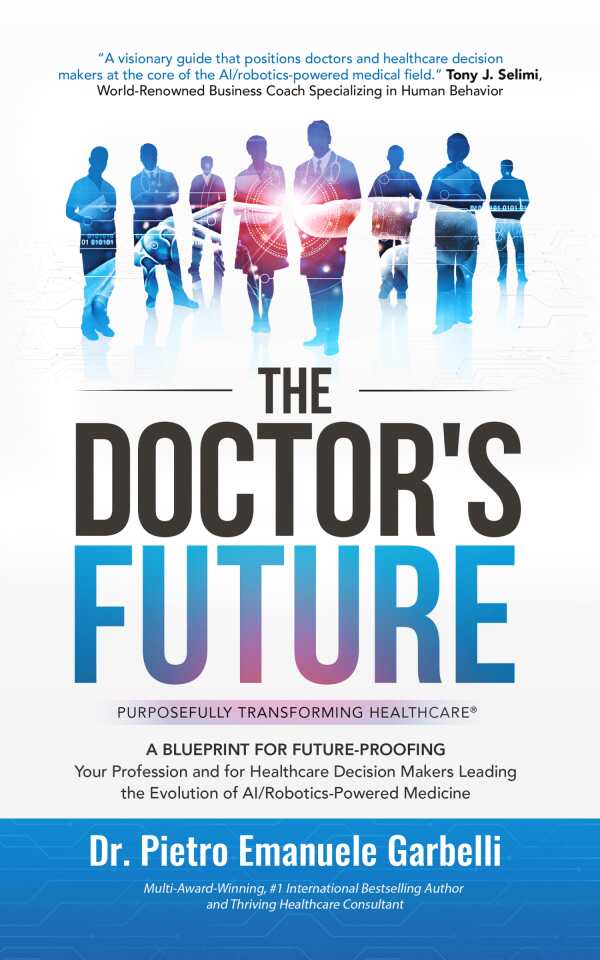The Doctor’s Future
A Blueprint for Future-Proofing You Profession and for Healthcare Decision Makers Leading the Evolution of AI/Robotics-Powered Medicine
The Doctor’s Future is a constructive healthcare primer about preserving professional values in a technology-driven era.
Pietro Emanuele Garbelli’s urgent health-care guide The Doctor’s Future is about medicine in an age of automation and algorithmic decision-making.
About how artificial intelligence and robotics reshape clinical workflows, institutional operations, and professional identity, this text documents applications across imaging, predictive analytics, ambient documentation, telehealth, and surgical robotics and argues for a shift from passive adaptation to active leadership within the profession. There are ethical and legal analyses of specifics and survey results too. The book’s Healthcare Convergence Framework is suggested as a means of preserving clinical judgment and benefiting from the efficiencies of automation; it converts broad principles into discrete categories that are suitable for policy development and curricular design and appears alongside a useful lexicon for conversations among clinicians, administrators, and technology teams.
Progressing from historical context to discussions of ethical and regulatory challenges, the book envisions worst-case scenarios before concluding with prescriptive chapters oriented toward training, governance, and strategy. Its blend of narrative and reference is edifying, as is the fact that it handles complex topics in an accessible but nuanced manner. Its examples are concrete, rendering abstract risks tangible, though the book’s sometimes speculative posture jars with its more evidence-based approaches, undermining its analytical authority. Further, the repetition of core themes, including professional preservation, ethical guardrails, and regulatory urgency, while useful for reinforcing the thesis, produces redundancy that limits the book’s forward momentum.
The book’s second critical focus concerns translation from concept to operation, forwarding policy proposals and training recommendations as a conceptual roadmap. Its operational details are sparse, however. Questions about how clinicians will secure influence within systems governed by vendor contracts and regulatory frameworks receive limited attention, for instance, while legal topics, including those related to data governance, algorithmic transparency, and malpractice, are handled sans adjudicative models and institutional templates. Stepwise playbooks and pilot protocols are absent, weakening the book’s ability to prepare operational leaders.
In the end, the book’s originality rests in its syntheses more than in any single claim it makes. Its use cases for AI in imaging and telehealth are quite familiar, though here repackaged in a distinctive, practitioner-focused convergence model. However, the book’s insistence on placing clinical judgment at the center of technological adoption functions as a unifying ethic rather than a novel technical proposal. Still, the citations of reputable sources, alongside the book’s integration of survey data with operational anecdotes, makes this a strategic primer and a notable entry point for further study. It encourages action without proposing simple fixes, revealing policy and ethical blind spots while setting out a constructive agenda to preserve professional values in a technology-driven era, reflective of a coherent set of priorities and a moral register to guide institutional planning and curriculum design.
The Doctor’s Future is a pragmatic medical guidebook that positions clinical judgment at the center of AI-driven care.
Reviewed by
John M. Murray
Disclosure: This article is not an endorsement, but a review. The publisher of this book provided free copies of the book and paid a small fee to have their book reviewed by a professional reviewer. Foreword Reviews and Clarion Reviews make no guarantee that the publisher will receive a positive review. Foreword Magazine, Inc. is disclosing this in accordance with the Federal Trade Commission’s 16 CFR, Part 255.

